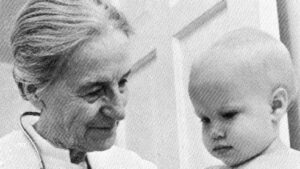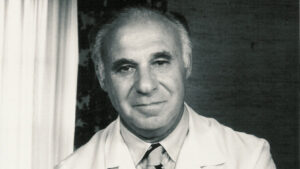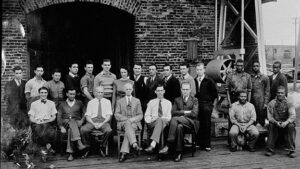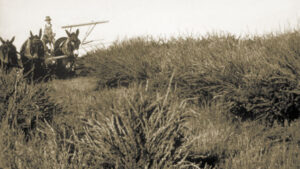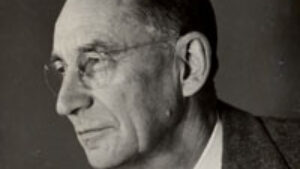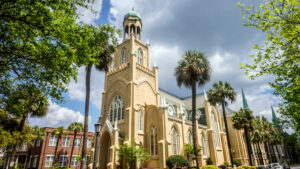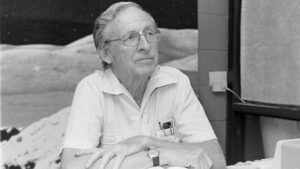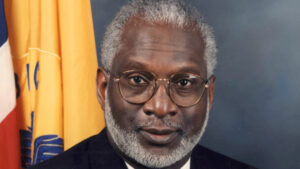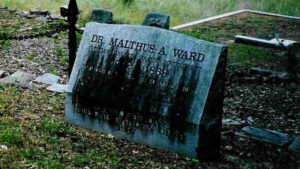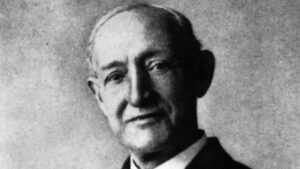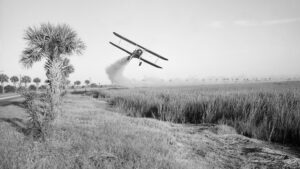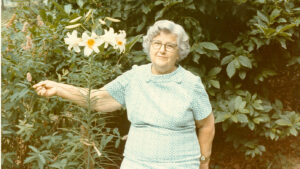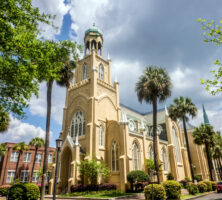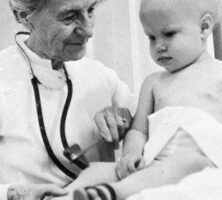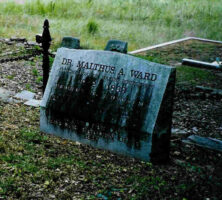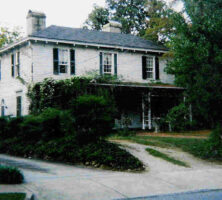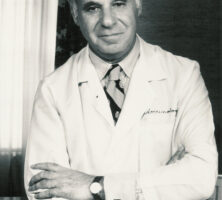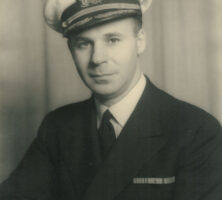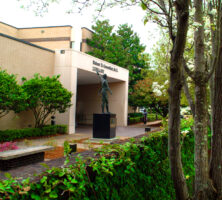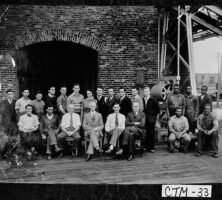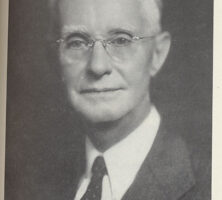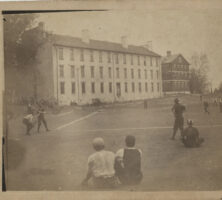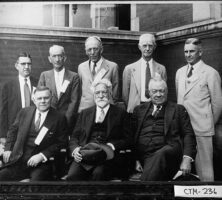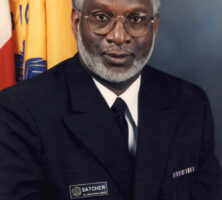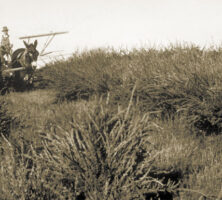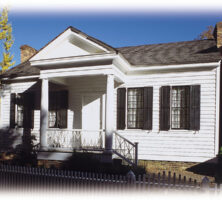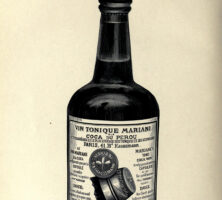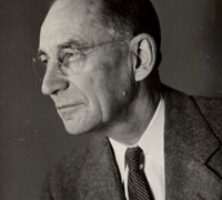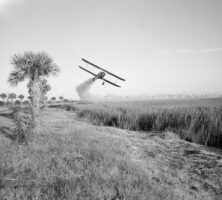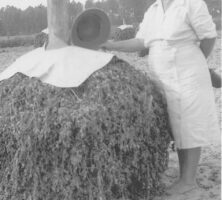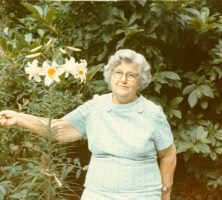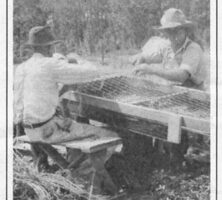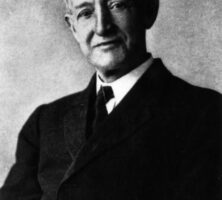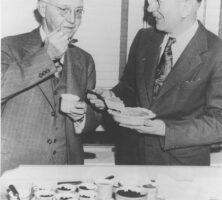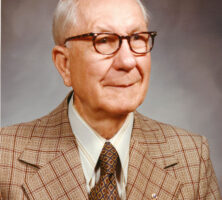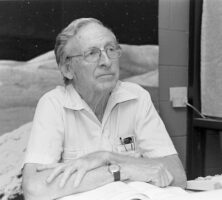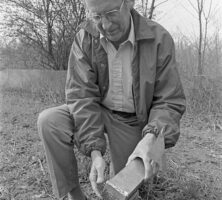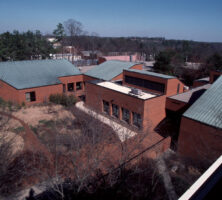The New Georgia Encyclopedia is supported by funding from A More Perfect Union, a special initiative of the National Endowment for the Humanities.
Congregation Mickve Israel in Savannah is the oldest Jewish congregation in the South and the third oldest in the United States. The congregation was founded during the establishment of the colony in 1733, and the current temple building was completed in 1878.
Photograph by Mark Kortum
The New Georgia Encyclopedia does not hold the copyright for this media resource and can neither grant nor deny permission to republish or reproduce the image online or in print. All requests for permission to publish or reproduce the resource must be submitted to the rights holder.
Leila Denmark, a pediatrician in Alpharetta, examines a patient. Denmark opened her practice in 1931 and retired in 2001, at the age of 103, as the oldest practicing pediatrician in the nation. In addition to running her private practice, Denmark conducted research that led to the development of the pertussis (or whooping cough) vaccine.
Courtesy of Jack Tarver Library Special Collections, Mercer University
The New Georgia Encyclopedia does not hold the copyright for this media resource and can neither grant nor deny permission to republish or reproduce the image online or in print. All requests for permission to publish or reproduce the resource must be submitted to the rights holder.
The Athens Garden Club installed a marker at the grave site of Malthus Ward, the first professor of natural history at the University of Georgia, in 1987. After leaving the university in 1842, Ward opened a commercial garden in Athens and founded the Horticultural Society of Georgia.
Photograph by LeAnna Biles Schooley
The New Georgia Encyclopedia does not hold the copyright for this media resource and can neither grant nor deny permission to republish or reproduce the image online or in print. All requests for permission to publish or reproduce the resource must be submitted to the rights holder.
Trees planted by natural historian Malthus Ward during the 1830s still stand outside his former home on Dearing Street in Athens. During his tenure as a professor at the University of Georgia, Ward maintained a botanical garden on the property.
Photograph by LeAnna Biles Schooley
The New Georgia Encyclopedia does not hold the copyright for this media resource and can neither grant nor deny permission to republish or reproduce the image online or in print. All requests for permission to publish or reproduce the resource must be submitted to the rights holder.
Robert B. Greenblatt, a native of Montreal, Canada, is credited with pioneering the discipline of endocrinology during his tenure at the Medical College of Georgia (later Georgia Health Sciences University) in Augusta, where he served as chair of the endocrinology department from 1946 to 1972.
Courtesy of Historical Collections and Archives, Robert B. Greenblatt, M.D. Library, Georgia Health Sciences University
The New Georgia Encyclopedia does not hold the copyright for this media resource and can neither grant nor deny permission to republish or reproduce the image online or in print. All requests for permission to publish or reproduce the resource must be submitted to the rights holder.
During World War II, noted endocrinologist Robert B. Greenblatt joined the U.S. Navy. During his service, Greenblatt studied the effects of the atomic bomb dropped on Nagasaki, Japan.
Courtesy of Historical Collections and Archives, Robert B. Greenblatt, M.D. Library, Georgia Health Sciences University
The New Georgia Encyclopedia does not hold the copyright for this media resource and can neither grant nor deny permission to republish or reproduce the image online or in print. All requests for permission to publish or reproduce the resource must be submitted to the rights holder.
In 1988 the library at Georgia Health Sciences University in Augusta was renamed in memory of Robert B. Greenblatt, the renowned endocrinologist who performed groundbreaking infertility research at the institution.
Photograph by Phil Jones, Georgia Health Sciences University
The New Georgia Encyclopedia does not hold the copyright for this media resource and can neither grant nor deny permission to republish or reproduce the image online or in print. All requests for permission to publish or reproduce the resource must be submitted to the rights holder.
Charles Herty (seated, fourth from left) is pictured with staff members at his Savannah Pulp and Paper Laboratory, circa 1933. Herty founded the lab in 1931 to develop techniques for producing newsprint from southern pine trees.
Courtesy of Georgia Archives, Vanishing Georgia, #
ctm033.
The New Georgia Encyclopedia does not hold the copyright for this media resource and can neither grant nor deny permission to republish or reproduce the image online or in print. Requests for permission to publish or reproduce the resource should be submitted to the Georgia Archives.
Charles Herty, a native of Milledgeville, was a renowned chemist known for his contributions to both the forestry and paper industries during his career. While a professor at the University of Georgia in the 1890s, Herty also established the university's athletic program.
Courtesy of Georgia Historical Society, Foltz Photography Studio (Savannah, Ga.), photographs, 1899-1960, #1360-25-10-14.
The New Georgia Encyclopedia does not hold the copyright for this media resource and can neither grant nor deny permission to republish or reproduce the image online or in print. All requests for permission to publish or reproduce the resource must be submitted to Georgia Historical Society.
University of Georgia students play baseball in 1893 at a field located on the northwest corner of campus. Charles Herty, a chemistry professor who was named director of the Department of Physical Culture at UGA in 1894, enlarged the field and built a grandstand in 1896. The site was later named Herty Field in his honor.
The New Georgia Encyclopedia does not hold the copyright for this media resource and can neither grant nor deny permission to republish or reproduce the image online or in print. Requests for permission to publish or reproduce the resource should be submitted to the Hargrett Manuscript and Rare Book Library at the University of Georgia.
The New Georgia Encyclopedia does not hold the copyright for this media resource and can neither grant nor deny permission to republish or reproduce the image online or in print. All requests for permission to publish or reproduce the resource must be submitted to the rights holder.
Charles Herty, an internationally recognized chemist from Georgia, meets in Savannah with leaders of the forestry and paper industries in the 1930s. Herty stands fourth from the left, and the philanthropist George Foster Peabody sits in the center.
Courtesy of Georgia Archives, Vanishing Georgia, #
ctm236.
The New Georgia Encyclopedia does not hold the copyright for this media resource and can neither grant nor deny permission to republish or reproduce the image online or in print. Requests for permission to publish or reproduce the resource should be submitted to the Georgia Archives.
Dr. David Satcher was the thirteenth director of the Centers for Disease Control and Prevention and the sixteenth surgeon general of the United States.
Image from Wikimedia
The New Georgia Encyclopedia does not hold the copyright for this media resource and can neither grant nor deny permission to republish or reproduce the image online or in print. All requests for permission to publish or reproduce the resource must be submitted to the rights holder.
The New Georgia Encyclopedia does not hold the copyright for this media resource and can neither grant nor deny permission to republish or reproduce the image online or in print. All requests for permission to publish or reproduce the resource must be submitted to the rights holder.
A researcher at the Georgia Experiment Station in Griffin plows a field behind a three-mule team in 1900. Around this time, scientists at the station developed the deep furrow method of planting winter oats, a technique that saved millions of dollars for farmers in the South.
Courtesy of University of Georgia College of Agricultural and Environmental Sciences
The New Georgia Encyclopedia does not hold the copyright for this media resource and can neither grant nor deny permission to republish or reproduce the image online or in print. All requests for permission to publish or reproduce the resource must be submitted to the rights holder.
A 1960 Atlanta Coca-Cola Bottling Company store display. Coca-Cola drinks have appeared in a variety of bottle shapes and sizes over the years, settling finally into its distinctive "hobbleskirt" bottle in 1916.
Courtesy of Special Collections & Archives, Georgia State University Library, Tracy O'Neal Photographic Collection, 1923-1975.
The New Georgia Encyclopedia does not hold the copyright for this media resource and can neither grant nor deny permission to republish or reproduce the image online or in print. Requests for permission to publish or reproduce the resource should be submitted to Special Collections and Archives at Georgia State University.
The New Georgia Encyclopedia does not hold the copyright for this media resource and can neither grant nor deny permission to republish or reproduce the image online or in print. All requests for permission to publish or reproduce the resource must be submitted to the rights holder.
This Greek revival-style cottage, at 11 Seventh Street in Columbus, was occupied by John Stith Pemberton and his family, 1855-60. Pemberton, a druggist in Columbus and later Atlanta, was the originator of Coca-Cola. The apothecary, once the kitchen, houses unique Coke memorabilia.
Courtesy of Historic Columbus Foundation
The New Georgia Encyclopedia does not hold the copyright for this media resource and can neither grant nor deny permission to republish or reproduce the image online or in print. All requests for permission to publish or reproduce the resource must be submitted to the rights holder.
John Stith Pemberton based "Pemberton's French Wine Coca," a drink that was very popular in Atlanta, on Vin Mariani, a French beverage formulated by Mariani & Company of Paris.
Image from Wikimedia
The New Georgia Encyclopedia does not hold the copyright for this media resource and can neither grant nor deny permission to republish or reproduce the image online or in print. All requests for permission to publish or reproduce the resource must be submitted to the rights holder.
The New Georgia Encyclopedia does not hold the copyright for this media resource and can neither grant nor deny permission to republish or reproduce the image online or in print. All requests for permission to publish or reproduce the resource must be submitted to the rights holder.
Dr. G. Lombard Kelly served as dean and president of the Medical College of Georgia (later Georgia Health Sciences University) from the 1930s to the early 1950s. Kelly also wrote short stories, children's stories, and news articles, and he collaborated with other professionals on numerous medical papers.
Courtesy of George L. Kelly
The New Georgia Encyclopedia does not hold the copyright for this media resource and can neither grant nor deny permission to republish or reproduce the image online or in print. All requests for permission to publish or reproduce the resource must be submitted to the rights holder.
A Stearman biplane sprays an insecticide during malaria control operations in Savannah.
Courtesy of Centers for Disease Control and Prevention, Department of Health and Human Services
The New Georgia Encyclopedia does not hold the copyright for this media resource and can neither grant nor deny permission to republish or reproduce the image online or in print. All requests for permission to publish or reproduce the resource must be submitted to the rights holder.
In 1933 Naomi Chapman Woodroof was hired by the Coastal Plain Experiment Station (later University of Georgia Tifton campus) and assigned to a long-term research project on peanuts. Her research was a key component in transforming peanuts from a crop for hog feed to an essential food product.
Courtesy of Lawrence Akers
The New Georgia Encyclopedia does not hold the copyright for this media resource and can neither grant nor deny permission to republish or reproduce the image online or in print. All requests for permission to publish or reproduce the resource must be submitted to the rights holder.
Agriculture pioneer Naomi Chapman Woodroof never sought fame or recognition, and it was not until after her death that she received both. The pavilion showcasing Georgia's agricultural products for visitors to the 1996 Olympics in Atlanta was relocated to the campus of the Georgia Experiment Station and named the Naomi Chapman Woodroof Agricultural Pavilion.
Courtesy of Lawrence Akers
The New Georgia Encyclopedia does not hold the copyright for this media resource and can neither grant nor deny permission to republish or reproduce the image online or in print. All requests for permission to publish or reproduce the resource must be submitted to the rights holder.
One of the many innovations introduced by Naomi Chapman Woodroof, an early pioneer in peanut research, was the use of bedsprings to separate peanuts from the plant during harvest. Woodroof worked at the Coastal Plain Experiment Station (later University of Georgia Tifton campus) from 1933 to 1967.
Courtesy of Jane Woodroof Akers
The New Georgia Encyclopedia does not hold the copyright for this media resource and can neither grant nor deny permission to republish or reproduce the image online or in print. All requests for permission to publish or reproduce the resource must be submitted to the rights holder.
Though not a native Georgian, Henry Clay White spent most of his life in Athens, where he became a fixture of UGA's science program. He did much to advance the school's curriculum, even while making a name for himself in the international science community.
The New Georgia Encyclopedia does not hold the copyright for this media resource and can neither grant nor deny permission to republish or reproduce the image online or in print. All requests for permission to publish or reproduce the resource must be submitted to the rights holder.
Clarence Birdseye (left), founder of Birdseye Frozen Foods, tastes products developed through the research efforts of Dr. Jasper Guy Woodroof (right) in 1940.
Courtesy of Lawrence Akers
The New Georgia Encyclopedia does not hold the copyright for this media resource and can neither grant nor deny permission to republish or reproduce the image online or in print. All requests for permission to publish or reproduce the resource must be submitted to the rights holder.
Jasper Guy Woodroof, a pioneer in food science and technology and often called the "father of food science," made outstanding scientific and technical contributions to the food industry over the course of his professional career.
Courtesy of Lawrence Akers
The New Georgia Encyclopedia does not hold the copyright for this media resource and can neither grant nor deny permission to republish or reproduce the image online or in print. All requests for permission to publish or reproduce the resource must be submitted to the rights holder.
In 1964, as president of the Ecological Society of America, Odum announced in the journal BioScience the establishment of a "new ecology," a "systems ecology" that dealt with the world as a whole, bringing all of the ecosystem sciences together.
Courtesy of University of Georgia Photographic Services
The New Georgia Encyclopedia does not hold the copyright for this media resource and can neither grant nor deny permission to republish or reproduce the image online or in print. All requests for permission to publish or reproduce the resource must be submitted to the rights holder.
The New Georgia Encyclopedia does not hold the copyright for this media resource and can neither grant nor deny permission to republish or reproduce the image online or in print. All requests for permission to publish or reproduce the resource must be submitted to the rights holder.
Odum was instrumental in the founding of the University of Georgia's Savannah River Ecology Laboratory, University of Georgia Marine Institute on Sapelo Island, and the Institute of Ecology, which was later renamed in his honor.
Courtesy of University of Georgia Photographic Services
The New Georgia Encyclopedia does not hold the copyright for this media resource and can neither grant nor deny permission to republish or reproduce the image online or in print. All requests for permission to publish or reproduce the resource must be submitted to the rights holder.
The New Georgia Encyclopedia does not hold the copyright for this media resource and can neither grant nor deny permission to republish or reproduce the image online or in print. All requests for permission to publish or reproduce the resource must be submitted to the rights holder.
The Eugene P. Odum School of Ecology is the primary academic unit for ecological research and teaching at the University of Georgia.
Courtesy of University of Georgia Photographic Services. Photograph by Paul Efland
The New Georgia Encyclopedia does not hold the copyright for this media resource and can neither grant nor deny permission to republish or reproduce the image online or in print. All requests for permission to publish or reproduce the resource must be submitted to the rights holder.
The New Georgia Encyclopedia does not hold the copyright for this media resource and can neither grant nor deny permission to republish or reproduce the image online or in print. All requests for permission to publish or reproduce the resource must be submitted to the rights holder.
Odum, the "father of modern ecology" discusses the unusual organization and sustainability of the coral reef.
Video by Darby Carl Sanders, New Georgia Encyclopedia
The New Georgia Encyclopedia does not hold the copyright for this media resource and can neither grant nor deny permission to republish or reproduce the image online or in print. All requests for permission to publish or reproduce the resource must be submitted to the rights holder.
